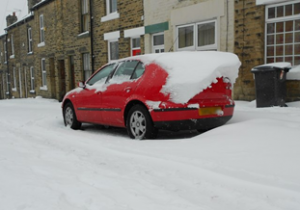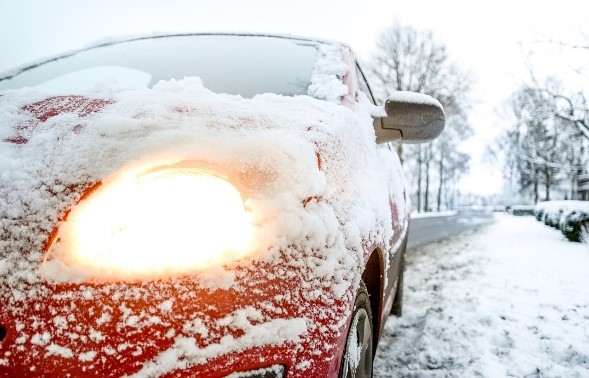Published on: 21/01/2022
With the UK well into winter and frost prominent across the UK, are you taking steps to ensure that your car is well maintained and safe during the cold months? The Trust My Garage blog has some handy tips to help protect you and your car this season!
Do I need Antifreeze?
Antifreeze stops the water in your engine’s cooling system from freezing, and potentially causing significant damage. As well as preventing the water from freezing, antifreeze raises the boiling point of the engines coolant to prevent overheating. The fluid also protects your engine from internal corrosion, aids heat transfer, and prevents scale from building up internally, all of which could result in costly repair bills.
You can buy concentrated antifreeze or ready mixed with water. Always check the pack’s instructions for the right ratio to use, as well as your vehicle’s Owner’s Manual, to make sure you use the correct variety for your car, as recommended by the manufacturer.

Braking
We all know brakes are an essential part of any car and therefore should be regularly checked and well maintained.
It is particularly important to check that your brakes are working correctly at this time of the year, when wet and icy roads are common. When you’re driving in the rain, your stopping distance is double what it would be on a dry road. This increases even more if you are driving in icy conditions, rising up to 10 times the stopping distance needed in dry weather.
Listen out for warning signs such as your brakes grinding or squeaking, or your car pulling you to one side or the other when you apply the brakes, all of which could indicate your braking system needs attention.
Check your tyres
Wet and icy roads require a deeper tyre tread than dry roads, the legal requirement for tread depth is 1.6 mm but it is recommended that your tread depth be 3 mm for driving in the winter months.
To learn all you need to know about ensuring your vehicle’s tyres are ready for the road, regardless of the time of year, read our “What to do when… you need to check your vehicle’s tyres” post.
Winter tyres are designed to offer optimum traction and grip in cold, icy conditions. If you are unsure about driving in the icy weather, winter tyres are good to use as they outperform your standard ‘summer’ tyres for traction in lower temperatures, providing improved cornering grip and braking.
If you have a spare tyre in the boot of your car, don’t forget to check this too, both for condition and the tyre pressure to ensure it is usable should you need it. Having a spare tyre is useful in situations where you may find yourself with a damaged wheel or a sudden puncture, however it is important to know what the rules are when it comes to using them, as many spare tyres are different in size and structure compared to the standard tyre fitted to cars and may be restricted to lower driving speed and vehicle load. Check your vehicle handbook for the instructions specific to your vehicle.
Lights
Before setting off on a journey, it’s a good idea to check your vehicle’s lights, you can either walk around the vehicle to conduct a check, or ask a passenger to check them whilst you operate the switch, and don’t forget the brake and reverse lights too.
If any lights are dim or aren’t working, including fog lights and number plate lights, you should get them replaced as soon as possible.
The weather this time of year means that there is a lot of dirt and grit being thrown up from the road surface by other vehicles, and whilst it is not illegal to have a dirty car, you need to ensure that your number plates are clean and easy to read. Many cars these days have headlamp washers to keep your head lights clean, but it is also important that your rear lights are clean and visible. In the event of snow fall, make sure you clear ice and snow from your front and rear lights, to ensure you have good visibility and that other drivers can see you.

Keep windows clear
Before setting off on your journey, it is important that your car windows are clear of any potential obstruction, including ice and snow. This can be achieved by a simple ice scraper or a can of de-icer. It is worth mentioning that you may need to leave for work early, so that you have plenty of time to clear your car’s windows before you set off driving!
If it has snowed, using a snow brush is a good way to clear your car. A lot of people forget to clear their car roof of snow before setting off – it is important that you clear the snow from your roof, as not doing so could potentially cause the snow to hinder your vision when braking or could fly from your roof and land on someone’s windscreen behind you, impairing their vision and potentially resulting in a crash.

Window Wipers
The winter weather can affect your wipers and windscreen. Take a look at your wipers and make sure they are in good condition. Check the wiper rubbers for cuts and tears and if they are damaged, replace them to ensure they clear your windscreen effectively.
Before turning on your wipers in frosty conditions, ensure that your wipers are not frozen to the screen, as turning on the wipers whilst they are frozen to the window can tear the wiper blade rubbers or even blow a fuse.
You should also make sure that your car has plenty of screen wash, as driving in the winter can bring up a lot of dirt and mud, impairing your vision. It is handy to remember that you can purchase a winter screen wash that does not freeze in the cold weather.
Battery
Did you know that cold temperatures reduce the efficiency of a vehicle’s battery? If you feel that your battery is not operating effectively, it may need charging or even replacing. If you are unsure as to the condition of your battery, consider having a set of jump leads in your car just in case you need them.
There are some signs you can look out for to tell if your car battery is running low. You may find that your headlights dim when the car is ticking over, also when starting your car the starter motor may seem to turn the engine over much slower than normal.
If you are concerned about the condition of your battery, your local Trust My Garage member can advise you.
Winter Breakdown Essentials
If you do suffer the unfortunate experience of a breakdown, it’s important to keep some essentials in the car, so you can stay warm and safe when waiting for help in winter weather. Consider keeping the following items in your car in case of an emergency:
- Warning triangle – lets other drivers know your situation
- A high-vis jacket or vest– this helps you stand out and ensures you are visible to other road users
- Cat litter or sand – to put under the wheel to help traction in slippery conditions
- Snow shovel or spade
- Ice scraper
- Warm clothes and footwear
- Snacks and water
- Torch
- Mobile phone and a portable charger
- Blanket
- Jump leads
- First aid kit
- Heat pad – If you are stranded in the snow and the exhaust pipe is covered, it can be dangerous to run the engine, so keeping some outdoor hand warmers in your car will help you stay warm.
Keep safe this winter with Trust My Garage
If you are unsure of your vehicle’s readiness for winter driving or if you experience any issues with your car, Trust My Garage members are here to help you.
Whether it’s for a check-up, service or repair, the Chartered Trading Standards Institute (CTSI) approved code of conduct that our members follow means that you and your motor both get the best possible service – no matter what the weather!
For more information about Trust My Garage or to locate your nearest TMG member visit www.trustmygarage.co.uk.

Leave a Reply